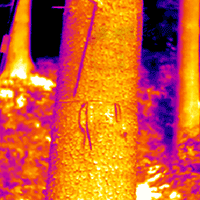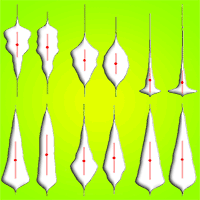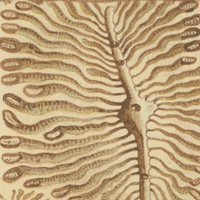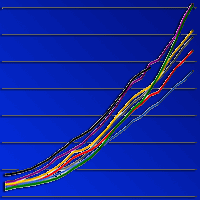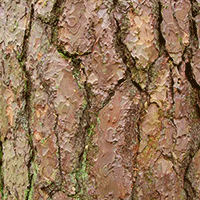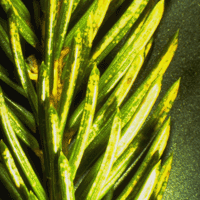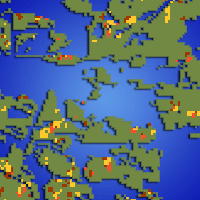
A bark beetle infestation predictive model based on satellite data in the frame of decision support system TANABBO
Renata Duračiová (1), Milan Muňko (1), Ivan Barka (2), Milan Koreň (3), Karolina Resnerová (4), Jaroslav Holuša (4), Miroslav Blaženec (5), Mária Potterf (6), Rastislav Jakuš (4-5)
iForest - Biogeosciences and Forestry, Volume 13, Issue 3, Pages 215-223 (2020)
doi: https://doi.org/10.3832/ifor3271-013
Published: Jun 06, 2020 - Copyright © 2020 SISEF
Research Articles
Abstract
The European spruce bark beetle Ips typographus L. causes significant economic losses in managed coniferous forests in Central and Northern Europe. New infestations either occur in previously undisturbed forest stands (i.e., spot initiation) or depend on proximity to previous years’ infestations (i.e., spot spreading). Early identification of newly infested trees over the forested landscape limits the effective control measures. Accurate forecasting of the spread of bark beetle infestation is crucial to plan efficient sanitation felling of infested trees and prevent further propagation of beetle-induced tree mortality. We created a predictive model of subsequent year spot initiation and spot spreading within the TANABBO decision support system. The algorithm combines open-access Landsat-based vegetation change time-series data, a digital terrain model, and forest stand characteristics. We validated predicted susceptibility to bark beetle attack (separately for spot initiation and spot spreading) against beetle infestations in managed forests in the Bohemian Forest in the Czech Republic (Central Europe) in yearly time steps from 2007 to 2010. The predictive models of susceptibility to bark beetle attack had a high degree of reliability (area under the ROC curve - AUC: 0.75-0.82). We conclude that spot initiation and spot spreading prediction modules included within the TANABBO model have the potential to help forest managers to plan sanitation felling in managed forests under pressure of bark beetle outbreak.
Keywords
Spatial Predictive Model, Bark Beetle Infestation, GIS, ROC Curve, Norway Spruce
Authors’ Info
Authors’ address
Milan Muňko
Faculty of Civil Engineering, Slovak University of Technology in Bratislava, Bratislava (Slovakia)
Faculty of Forestry, Technical University in Zvolen, Zvolen (Slovakia)
Jaroslav Holuša 0000-0003-1459-0331
Rastislav Jakuš 0000-0003-2280-1952
Faculty of Forestry and Wood Sciences, Czech University of Life Sciences, Prague (Czech Republic)
Rastislav Jakuš 0000-0003-2280-1952
Institute of Forest Ecology, Slovak Academy of Sciences, Zvolen (Slovakia)
Department of Biological and Environmental Sciences, University of Jyvaskyla, Jyvaskyla, Finland
Corresponding author
Paper Info
Citation
Duračiová R, Muňko M, Barka I, Koreň M, Resnerová K, Holuša J, Blaženec M, Potterf M, Jakuš R (2020). A bark beetle infestation predictive model based on satellite data in the frame of decision support system TANABBO. iForest 13: 215-223. - doi: 10.3832/ifor3271-013
Academic Editor
Massimo Faccoli
Paper history
Received: Oct 17, 2019
Accepted: Apr 05, 2020
First online: Jun 06, 2020
Publication Date: Jun 30, 2020
Publication Time: 2.07 months
Copyright Information
© SISEF - The Italian Society of Silviculture and Forest Ecology 2020
Open Access
This article is distributed under the terms of the Creative Commons Attribution-Non Commercial 4.0 International (https://creativecommons.org/licenses/by-nc/4.0/), which permits unrestricted use, distribution, and reproduction in any medium, provided you give appropriate credit to the original author(s) and the source, provide a link to the Creative Commons license, and indicate if changes were made.
Web Metrics
Breakdown by View Type
Article Usage
Total Article Views: 43685
(from publication date up to now)
Breakdown by View Type
HTML Page Views: 35744
Abstract Page Views: 4416
PDF Downloads: 2765
Citation/Reference Downloads: 14
XML Downloads: 746
Web Metrics
Days since publication: 2025
Overall contacts: 43685
Avg. contacts per week: 151.01
Citation Metrics
Article Citations
Article citations are based on data periodically collected from the Clarivate Web of Science web site
(last update: Mar 2025)
Total number of cites (since 2020): 18
Average cites per year: 3.00
Publication Metrics
by Dimensions ©
Articles citing this article
List of the papers citing this article based on CrossRef Cited-by.
References
Satellite-based regional system for observation of forest response to global environmental changes. In: “Advances in Geoinformation Technologies” (Horák J, Halounová L, Hlásny T, Kusendová D, Vozenílek V eds). Technical University of Ostrava, Ostrava, Czech Republic, pp. 1-14.
Gscholar
Constraint and preference modelling for spatial decision making with use of possibility theory. In: Proceedings of the “Hybrid Artificial Intelligence Systems” (Polycarpou M, De Carvalho ACPLF, Pan JS, Wozniak M, Quintian H, Corchado E eds). Salamanca (Spain) 11-13 June 2014. Springer International Publishing, Switzerland, pp. 145-155.
CrossRef | Gscholar
Biogeografické členení Ceské republiky [Biogeographical division of the Czech Republic]. Enigma, Praha, Czech Republic. [in Czech]
Gscholar
Guide to GIS and image processing - Volume 2. IDRISI production Clark University, Worcester, UK, pp. 170.
Gscholar
Signal detection theory and ROC analysis. Academic Press, New York, USA, pp. 277.
Gscholar
Multivariate data analysis (7th edn). Pearson Education Limited, London, UK, pp. 734.
Gscholar
Variabilità e mutabilità [Variability and mutability]. Reprinted in: “Memorie di metodologica statistica”, 1955 (Pizetti E, Salvemini T eds). Libreria Eredi Virgilio Veschi, Rome, Italy, pp. 156. [in Italian]
Gscholar
The solar radiation model for open source GIS: implementation and applications. In: Proceedings of the “Open source GIS - GRASS user’s conference 2002” (Ciolli M, Zatelli P eds). Trento (Italy) 11-13 Sept 2002. University of Trento, Trento, Italy, pp. 19.
Gscholar
Definition of spatial patterns of bark beetle Ips typographus (L.) outbreak spreading in Tatra Mountains (Central Europe), using GIS. In: Proceedings of the Conference “GTR NE-311 Survey and Management of Forest Insects” (Mc Manus M, Liebhold A eds). Kraków (Poland) 1-5 Sept 2002. USDA Forest Service, Newtown Square, PA, USA, pp. 25-32.
Online | Gscholar
Prognosis of bark beetle attacks in TANABBO model. In: “GIS and Databases in the Forest Protection in Central Europe” (Grodzki W eds). Centre of Exellence PROFEST at the Forest Reseach Institute, Warsaw, Poland, pp. 35-43.
Gscholar
TANABBO II model pro hodnocení rizika napadení lesních porostu lýkozroutem smrkovým Ips typographus (L.) [TANABBO II model for risk of Ips typographus (L.) attack assessment]. Lesnický pruvodce 1/2017. Výzkumný ústav lesního hospodárství a myslivosti, v. v. i., Jílovište, Czech Republic, pp. 71. [in Czech]
Gscholar
Applicability of support vector machines in landslide susceptibility mapping. In: “The Rise of Big Spatial Data, Lecture Notes in Geoinformation and Cartography” (Ivan I, Singleton A, Horák J, Inspektor T eds). Springer International Publishing AG, Cham, Switzerland, pp. 373-386.
CrossRef | Gscholar
TANABBO model: a remote sensing based early warning system for forest decline and bark beetle outbreaks in Tatra Mts. - overview. In: “GIS and Databases in the Forest Protection in Central Europe” (Grodzki W eds). Centre of Exellence PROFEST at the Forest Research Institute, Warsaw, Poland, pp. 15-34.
Gscholar
Applied predictive modeling. Springer Science + Business, New York, USA, pp. 600.
Gscholar
Storms, temperature maxima and the Eurasian spruce bark beetle Ips typographus - An infernal trio in Norway spruce forests of the Central European High Tatra Mountains. Agricultural and Forest Meteorology 242: 85-95.
CrossRef | Gscholar
Landscape-level spread of beetle infestations from windthrown- and beetle-killed trees in the non-intervention zone of the Tatra National Park, Slovakia (Central Europe). Forest Ecology and Management 432: 489-500.
CrossRef | Gscholar
Monitoring zdravotního stavu lesu z druzicových snímku [Forest health monitoring with the use of satellite images]. Ochrana prírody 58: 228-232. [in Czech]
Gscholar
The southern pine beetle. Technical Bulletin 1631, Expanded Southern Pine Beetle Research and Application Program, USDA Forest Service, Science and Education Administration, Pineville, LA, USA, pp. 265.
Gscholar
Multivariate geostatistics. An introduction with applications. Springer-Verlag, Berlin, Heidelberg, Germany, pp. 257.
Gscholar

